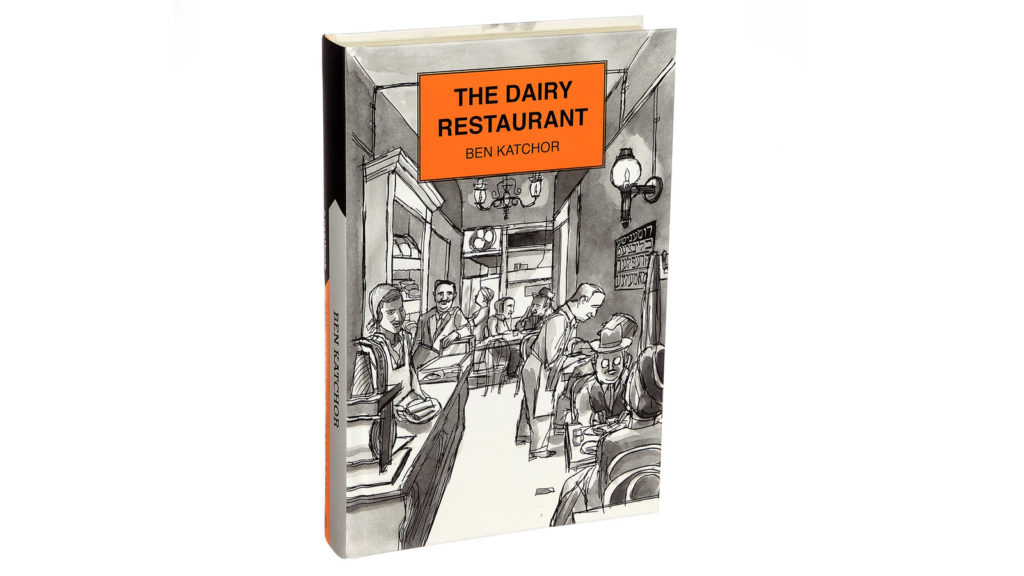
Like the Bible, Ben Katchor’s book The Dairy Restaurant begins in the Garden of Eden. But his paradise is a clean, well-lit diner where a weary Jew can order a plate of gefilte fish or some blintzes and sit and dream. An encyclopedic elegy to a way of eating and living, it is mournful, exhaustive, and deadpan funny in roughly equal measure. It is also unlike any book I have ever read.
In the works since the 80s and with a scope meant to eclipse the five hundred pages of this volume, Katchor begins his history of the Jewish dairy restaurant at the ultimate beginning, “The “Garden” in Eden is the first private eating place opened to the public that’s mentioned in the Bible.” In his retelling God, rebranded YHWH, is the first proprietor, serving a variety of vegetarian delights. He throws out his first customers for ordering off menu and condemns them to wander the world in futile search for some approximation of what they took for granted and lost.
Along the way, Katchor traces eating customs the world over, zeroing in on the plight of Jews in Europe. Held apart and restricted by laws and prejudice from the dominant population, they had to make their own institutions which conformed to their religious beliefs while allowing them to survive in the larger society. As business industrialized, there had to be places for workers to eat away from home. Thus the need for Kosher eateries.
This book is not for the lactose-intolerant. Through words and his trademark boxy, scratchy drawings, Katchor depicts a variety of European restaurants focused on milk and its byproducts. He even coins a term to describe the ur-customer of such places, a man with a milekhdike personality. Roughly translated from the Yiddish as milky, he is a man who prefers rumination to action. Think Sholom Aleichem’s Tevye the Milkman (to whom an entire chapter of the book is dedicated.)
As Jews migrated to the United States, they brought their language and customs with them. Katchor has seemingly tracked down records of every Jewish dairy restaurant ever established in New York, often citing a matchbook or proprietary sugar cube as the only extant clue to their existence. He lovingly lists them along with their owners and dates of operation. For long stretches his book is a kind of literary tomb, for as Ratner’s and Schimmel’s are replaced by Starbucks and Shake Shack, an entire culture dies with them. As restaurants become corporate chains their particularity is lost. In this case, it is not only a way of eating that is erased but an entire language, “A native Yiddish speaker transforms whatever he puts in his mouth by naming it as he eats it.”
The owners of family-owned Jewish restaurants sealed their own fate. They steered their children away from the business by showing them it was back-breaking work for only marginal return. Retaining cultural traditions and standards is no way to get rich. But by celebrating this vanishing industry Katchor amply illustrates what we lose when we give in to monoculture. He wonders late in the book whether his decades-long project will find an audience, “To the young vegan reader, the distinctions between meat and dairy eating are quaint issues of the past.” Yet, he lists a website where others can add to this esoteric history. All are welcome.
Ben Katchor has devoted much of his career to evoking an imagined world of strangely specific and archaic businesses and characters. By combing through expired phonebooks, languishing archives, and recording oral histories with aged survivors to assemble this unique book he has crafted a monument to an institution his longtime readers couldn’t be blamed for thinking he could have invented. It is a kind of backstory to the comic strips he’s best known for. I can see Julius Knipfl eating kugel in the window of one of these long-gone diners clear as day.
***
The Dairy Restaurant
by Ben Katchor
Schocken; 496 p.
Follow Vol. 1 Brooklyn on Twitter, Facebook, and sign up for our mailing list.
